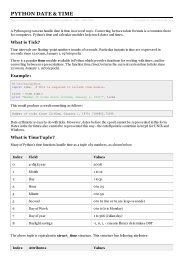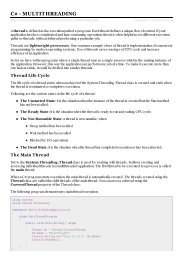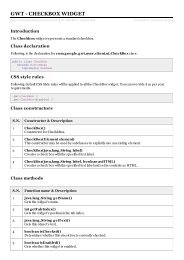Download Operating System Tutorial (PDF Version) - Tutorials Point
Download Operating System Tutorial (PDF Version) - Tutorials Point
Download Operating System Tutorial (PDF Version) - Tutorials Point
You also want an ePaper? Increase the reach of your titles
YUMPU automatically turns print PDFs into web optimized ePapers that Google loves.
I/O port<br />
An I/O port typically consists of four registers, called the status, control, data-in, and data-out<br />
registers.<br />
S.N. Register & Description<br />
1<br />
Status Register<br />
The status register contains bits that can be read by the host. These bits indicate states<br />
such as whether the current command has completed, whether a byte is available to be<br />
read from the data-in register, and whether there has been a device error.<br />
2<br />
Control register<br />
The control register can be written by the host to start a command or to change the mode<br />
of a device. For instance, a certain bit in the control register of a serial port chooses<br />
between full-duplex and half-duplex communication, another enables parity checking, a<br />
third bit sets the word length to 7 or 8 bits, and other bits select one of the speeds<br />
supported by the serial port.<br />
3<br />
Data-in register<br />
The data-in register is read by the host to get input.<br />
4<br />
Data-out register<br />
The data out register is written by the host to send output.<br />
TUTORIALS POINT<br />
Simply Easy Learning Page 64
















